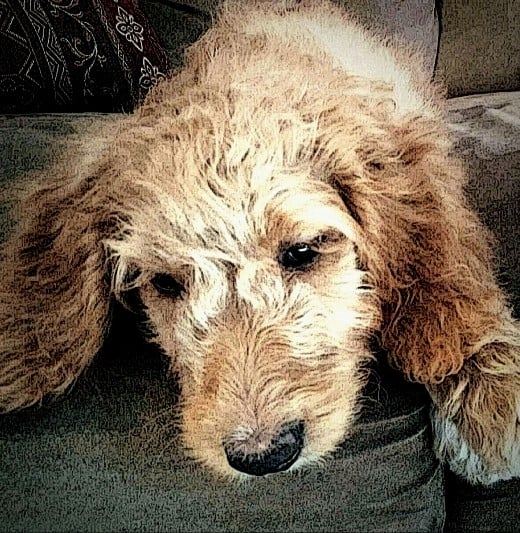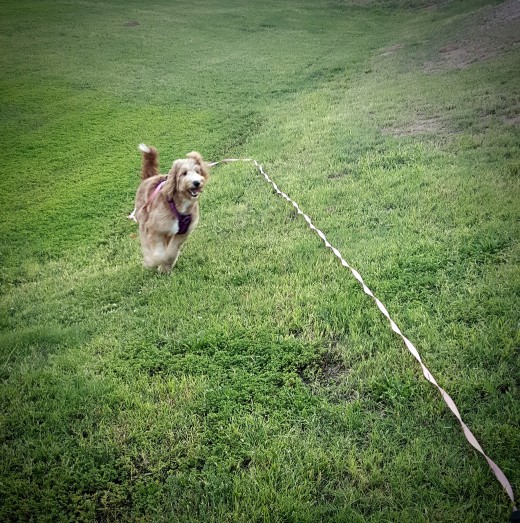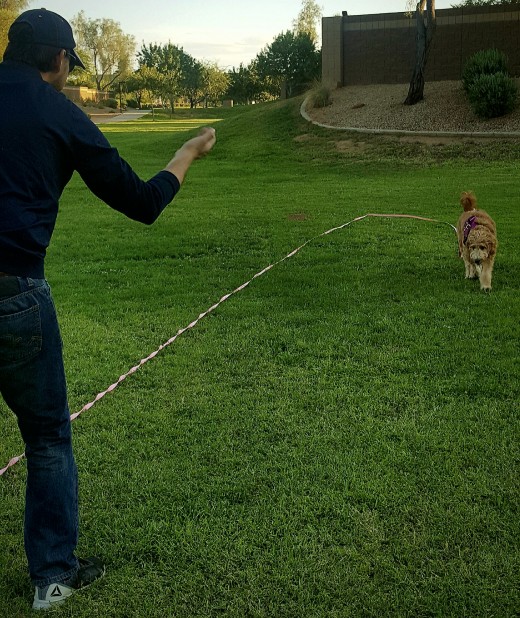- HubPages»
- Pets and Animals»
- Dogs & Dog Breeds»
- Dog Training
Training Your Goldendoodle Puppy. Sit, Stay, Good Dog.
Training Takes Time.
When training your Goldendoodle or any puppy it's important to have patience. Never yell at your dog. Never ever hit your dog. Instead, use positive reinforcement. Like praising your dog "good boy!", or offer the dog a treat. Even a favorite toy can be used to train your k9 friend. Above all don't give up, your dog loves to learn and will grasp the idea of being trained before long.
Old Dogs CAN Learn New Tricks
Have you ever heard of the expression "Old Dogs Can't Learn New Tricks."? Well, they were WRONG! Old Dogs can learn new tricks. In fact, the old dog loves to learn new tricks! With a few words of encouragement and a bag of treats; all the commands that we will be going over in this article can be learned even by the oldest of dogs.

Two things you should NEVER do while training your dog
1: Never hit your animal. This will do nothing helpful and will cause your dog anxiety and fear. In fact, hitting a dog or any other pet could cause its long term physical and mental trauma.
2: Don't yell at your dog. Yelling will likely cause the dog to get more hyper. Dogs usually will react according to the trainer's mannerisms. So if your yelling and excited, your dog will follow suit. Remain cool and calm and eventually, your dog will too. Yelling also could cause your pet mental trauma.

Teaching Your Dog New Tricks
Often times when thinking of training a dog, owners solely train the dog tricks like "shake", or "play dead". But it's important to train a dog the basics in mannerisms too. Goldendoodles are very intelligent so you might think that they will be easy to train, but sometime it may be just the contrary. Dogs with high intelligence often show rambunctiousness just because they are always thinking. Every command they will learn in the article is key to you and your dog having a good happy relationship. But there are a few tricks that you will want to make sure your dog has down for safety reasons. Such as "stay" or "no".
The 7 commands that every dog needs to know!
- #1 Sit
- #2 Stay
- #3 Off
- #4 Down
- #5 Come
- #6 Heel
- #7 No
#1: Training Your Dog to "Sit" And When It's Used.
Teaching a dog to sit is probably one of the most commonly used commands there is. But did you know it is probably the most important one there is too? The command "Sit" is a base training command (or stem command), as well as a control command. This means that many other commands stem from the sit command first. For example; when training "Stay" we first need the dog to sit. By having the dog sit first the trainer gets the dog's attention as well as calms the dog. This makes it considerably easier to set up the next command.

How To Teach Your Doodle To "Sit" on Command
To teach a dog to sit, simply tap the dog's rear end and give the command "Sit". Do this several times, if the dog sits then treat and praise the dog. If the dog does not sit after several attempts, they gently push the dog's rear end down in the sitting position while using the command "Sit". Once the dog is sitting praise and treat the dog. Also, use pointing to indicate to the dog that you want it to sit. Do this several times rewarding the dog for every successful sit.
#2: What is the "Stay" command, and why its important?
The command "Stay" is used to get your dog to be still in one spot and to be only allowed to move when given permission by the trainer. This command is one of the most important commands a dog needs to lean. The command "Stay" could even save your dog's life one day. Without it, your dog could run out the front door and get lost or worse hit by a car.

Training your Goldendoodle to "Stay" using positive reinforcement
The way to do this is to have your dog "sit" first. Next, using hand signals as well the command "stay", order your dog to stay put. You want to get the dog to stay in one position. If the dog listens reward it with a treat. If it's moving around at all, then no treat; the dog should be like a statue for the reward. Simply wait until the dog stops moving and quickly give it a treat (also praise the dog). The dog will quickly learn when it freezes, it gets praise and a treat. Repeat as needed.
Basic - Dog Training 101 (part 1)
view quiz statistics#3: Why Teaching The "Off" Command is Important.
Teaching your dog the "off" command teaches the dog not to jump on things. For example; you would use the "off" command if the dog were to jump at you with its front paws lunging towards you. You could also use the command if the dog were to jump on your counter top with its front paws. It is also a very important command because it could become a safety issue if there is a small child living with the dog. The dog could jump on the child and unintentionally cause injuries. Plus it's a good command to have just so your dog learns some mannerisms and is polite.

How to teach your Goldendoodle The "Off" Command
If your pet is a jumper here is how to train your dog to stay off. When the dog jumps on you grab their two front paws and say off over and over. Hold them in that position and continue to say off. Be careful when teaching this command! Make sure not to hold the paws to high or for too long so you do not harm your furry friend. Hold your dog just long enough to make sure he understands the unwanted behavior. Holding him there will become annoying to your pet and he will eventually stop jumping.

Jumping on countertops?
If your dog not only jumps on you but jumps on countertops, here is another method of training "Off". When your pet jumps on the counter and you'd like to change this behavior here's what to do. Simply fill a small plastic bottle with pennies on the bottom. As soon as your dog jumps on the counter say "No" and shake the bottle once. It's sure to grab your pet's attention and he will immediately jump down. Do this each and every time the paws touch the counter and down he will go. Begin to give your dog the freedom of being in the kitchen alone, or so they think they are alone. Hide around the corner or have a video camera in the area so that they can be watched at all times. If your pet jumps on the counter immediately enter the kitchen saying "No" and shake the bottle once. Again, off he will go. Continue this until your pet no longer jumps on the counter.
#4: Why Teach "Down" Command
The "Down" command is a trusted command. The dog is giving complete trust in its trainer. Your pet's guard is completely down when he is obeying this command. The bond between the trainer and the pet is tight at this point. The "Down" command is also an important command to train your trusted companion so that he can lye still for a period of time if need be. It can also be used for safety issues. For example, if someone is at the front door you may want your dog to lye down so he doesn't run out when its opened.

Teaching The "Down" Command With no Leash
The first thing you will want to do when teaching your dog the "Down" command is to have it sit. Next, simply use a treat to lure the dog down to the ground. If the dog follows the treat and lays down then reward the dog the food. Make sure to give your dog a treat when he follows the command and lays down. If that does not work then gently grab the dog's front paws and put the dog in the down position. Once the dog is in the down position say the command "down" then treat & praise the dog.

Training The Down Command With a Leash
Using the aid of a leash and collar can also help with the training of the "Down" command. Have your dog sit. Next, gently pull the leash towards the floor while saying "Down". When the dog reaches a laydown position then reward the dog with praise and a treat. Do this several times, until the dog understands the command.
Completing Training of The "Down" Command
Once your confident the dog knows the command fairly well, then try the command without the aid of a treat or leash. Using your pointer finger, point to the floor while using the command "Down". The dog should lay down and your training of the down command will be complete.
Basic - Training 101 (part 2)
view quiz statistics#5: How to Train Your Goldendoodle The "Come" Command.
To train your doodle the "Come" command you'll need a Lead Leash, a harness, and a large area of space (a fenced-in backyard is ideal). Lay the lead leash outstretched on the ground so that it is straight. Next, attach the leash to the dog's harness. Command the dog to "Sit", command the dog to "Stay". Then keeping your feet on the lead leash and walk it like a tightrope, about 5 paces. Turn around, while keeping at least one foot on the lead leash pick up the leash in front of you.
Teaching a Goldendoodle to "Come", When Called.
Teaching a command like "Come" can be extremely useful. What if your dog were to just start running off into the distance; how would you catch it? Let's face it, our four-legged friends are much faster than we are. Did you know? Your full-grown Goldendoodle can run up to 30mph! If you can't command your dog to come back it may run too far and get lost, hit by a car, or possibly stolen. That's why it is key to train your dog to "Come" on command.

Tow The Dog
With one foot still on the lead leash start towing the dog in. Do this while repeating the command "Come" over and over. When the dog reaches you, treat and praise it. Repeat this step several times each time putting more distance between you and the dog. Also, start changing from towing the dog; to encourage the dog to come with gentle tugs on the line.

Calling The Dog With "Come"
Eventually, the dog will catch on and you will no longer have to tug the line or tow the dog in. Simply say the command "Come" while using a hand signal, and your dog will come.
Lead Leash Dangers & Proper Use
While the lead leash is an important training tool, it also has its dangers if not handled properly. Here are a few safety tips for the use of a lead leash:

Lead Leash Safety Tip #1
Never, ever, let children play near a dog training on a lead leash. The dog could accidentally wrap the child up with the leash causing serious injuries or even death. When you're not using the leash be sure to keep it safely out of the reach of children.
Lead leash Burn Warning!

Lead Leash Safety Tip #2
Wear long pants when operating the lead leash, NEVER wear shorts. A lead leash is typically very long, 30 to 50 feet. While training your dog with the lead leash it could get wrapped around your legs. If the dog begins to run it will create a belt sander effect and can cause severe, and painful burns.
Use Your Foot Like a Break.

Lead Leash Tip #3
Try to keep the lead leash in front or to the side of you. Be aware of the placement of the leash at all times. The lead leash can quickly become a danger if you're not aware of its placement. You could easily trip on the leash, or get tripped by the dog running around you with it.
Try to Keep The Lead Leash From Getting Tangled With Your Feet.

Lead Leash Quick Tip #4
When training your dog, don't hold the lead leash anywhere but by the handle unless your wearing gloves. Holding the leash anywhere else could cause burns if the dog decides to run. To avoid this, simply drop the lead leash on the ground and lay it out straight. Using a harness, attach your dog to the lead leash. Step on the lead leash with your foot. Use your foot the same way you would use your break peddle.
#6: Why Your Dog Needs to Learn How to "Heel".
When walking your Goldendoodle puppy you're likely going to run into a lot of distractions. People walking by, cars, bicyclists, workers, basically everything and anything the dog sees moving is going to be a huge distraction for your puppy. So taking the dog on a walk may not be so easy for either of you. The dog will be jumping and pulling in every direction; you're going to get frustrated. That's when the "Heel" command will be a lifesaver. Using the "Heel" command you can take control of the walk, and make it more pleasant for both of you.

How to Teach a Goldendoodle Puppy to "Heel" on Command
To train the command "Heel" first start by walking your dog in a confined area like a long hallway. Walk your dog up and down the hallway, if your dog pulls one way or the other gently tug the leash while speaking the word "Heel". If the dog listens and stops pulling then treat the dog. It's important to try to keep slack on the leash while using this technique. Keep walking the dog in this manner until you think it's ready enough to try walking outside on a leash.
Using the "Heel" Command on Your Walk
While walking your dog use the "Heel" command whenever it becomes distracting or starts pulling. There should always be slack in the leash while walking your dog. Walk your dog at your pace, if you start to feel the dog pull, then either change direction saying "Heel", or tug the leash gently while saying the command. Do this over and over again until the dog learns the command.

Using "Heel" Before It's Too Late
Cutting the dog off before it can react in an unwanted manner, is key to stopping bad behavior when on a walk. For example, your Goldendoodle puppy may start going crazy, pulling, and jumping at strangers who are passing by. You will need to prevent that from happening altogether. As soon as you or your dog see someone coming, use the "Heel" command and walk the other direction. But what if you're trapped with people coming from both directions?
Using "Heel" in a Jam
If your out walking your slightly hyper Goldendoodle puppy and people are walking towards you from both directions; what should you do? Simply stop, tell the dog to "Sit". Tell the dog to "Stay". Hold the leash close. Wait for the people to pass by. If the dog moves at all, use the "Heel" command again and gently tug the line.
Walking The Dog, Not The Dog Walking ME.
Using the "Heel" command on every walk will improve how your dog walks with you. With each walk, your dog will begin to grasp the concept of "Heel". Before long you'll be walking leisurely with your dog.

#7: The "No" Command. How And When It's Used.
The "No" command is essential to any dog's training. In fact, it is one of the most important words a dog should learn. The "No" command probably has the widest scope of uses. It can be used to tell a dog not to pick up an item. Or, it may be used to tell a dog that its behavior is bad. It is also used as a complement to some of the other commands. For Example, you might tell your dog the command "No", followed by the command "Off". If your dog knows the command "No" it can make training easier in some areas.
How to train the "No" command
To train your dog no, first drop a treat down in front of them, block the treat with your hand immediately between the dog and the treat and say "No". If your pet lunges towards the treat say "No" again and re-position your hand between the treat and the dog once again. This usually stops the dog from going for the reward. Continue this cycle until your pet leaves the treat for at least 3 seconds. Reward your furry companion by saying "o.k." and offering the treat. As your pet successfully achieves this command, you will be able to allow more time to pass before offering the reward. Success! Your pet will then begin to understand that the "No" command also goes for other items you don't want them to get. If your pet doesn't quite grasp the concept with this method of training you could go a step further and use a leash. Using the same steps as above but with a leash. This will allow more control to hold the dog back away from the treat while saying "No".
A Trained Dog, is a Cool Dog.

Basic - Training 101 (part 3)
view quiz statisticsCongratulations! You've completed the top 7 Goldendoodle training commands.
Now your Goldendoodle mastered all our top 7 commands. Good Dog!
Thanks and good luck
Bow Wow or Woof!
Has your knowledge of dog training increased?
This content is accurate and true to the best of the author’s knowledge and is not meant to substitute for formal and individualized advice from a qualified professional.
© 2019 Jason Nicolosi








